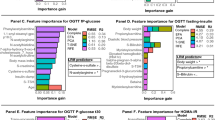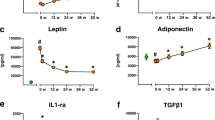Abstract
Non-human primates are valuable models for the study of insulin resistance and human obesity. In baboons, insulin sensitivity levels can be evaluated directly with the euglycemic clamp and is highly predicted by adiposity, metabolic markers of obesity and impaired glucose metabolism (i.e. percent body fat by DXA and hemoglobin A1C). However, a simple method to screen and identify obese insulin resistant baboons for inclusion in interventional studies is not available. We characterized a population of obese nondiabetic, insulin resistant baboons using the euglycemic clamp technique and used a multivariate linear regression analysis (after adjustment for gender) to test three different predictive models for insulin sensitivity. In the first model, abdominal circumference explained 63% of insulin mediated glucose uptake. The second model, which included fasting plasma insulin (log transformed) and abdominal circumference, explained 69% of insulin-stimulated glucose uptake. The third model, which contained abdominal circumference and 1/log (FPI+FPG), explained 70% of insulin sensitivity. In baboons, simple morphometric measurements of adiposity/obesity, i.e. abdominal circumference, plus baseline markers of glucose metabolism, i.e. fasting plasma glucose and insulin, provide a feasible method to screen and identify overweight/obese insulin resistant baboons for inclusion interventional studies aimed to study human obesity and type 2 diabetes.
Similar content being viewed by others
Article PDF
Author information
Authors and Affiliations
Rights and permissions
About this article
Cite this article
Chavez, A., Gastaldelli, A., Lopez-Alvarenga, J. et al. Predictive Models of Insulin Resistance Derived from Simple Morphometric and Metabolic Measurements Related to Obesity in Baboons.. Nat Prec (2008). https://doi.org/10.1038/npre.2008.2429.1
Received:
Accepted:
Published:
DOI: https://doi.org/10.1038/npre.2008.2429.1



